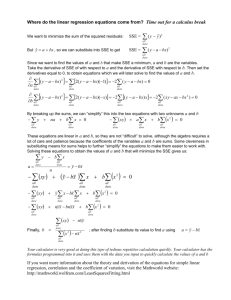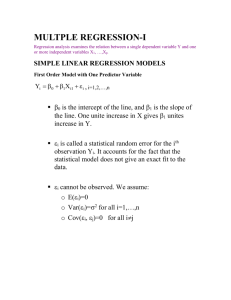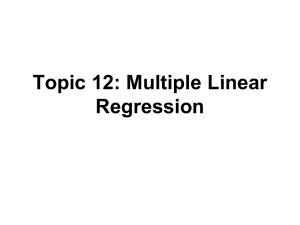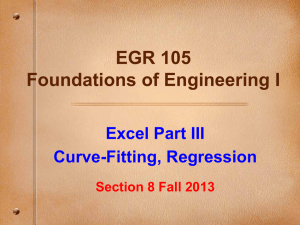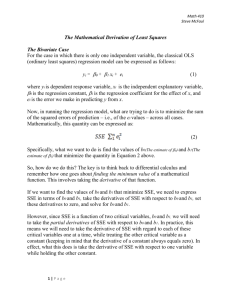Regression Analysis Sample Problems: Homework & Exams
advertisement
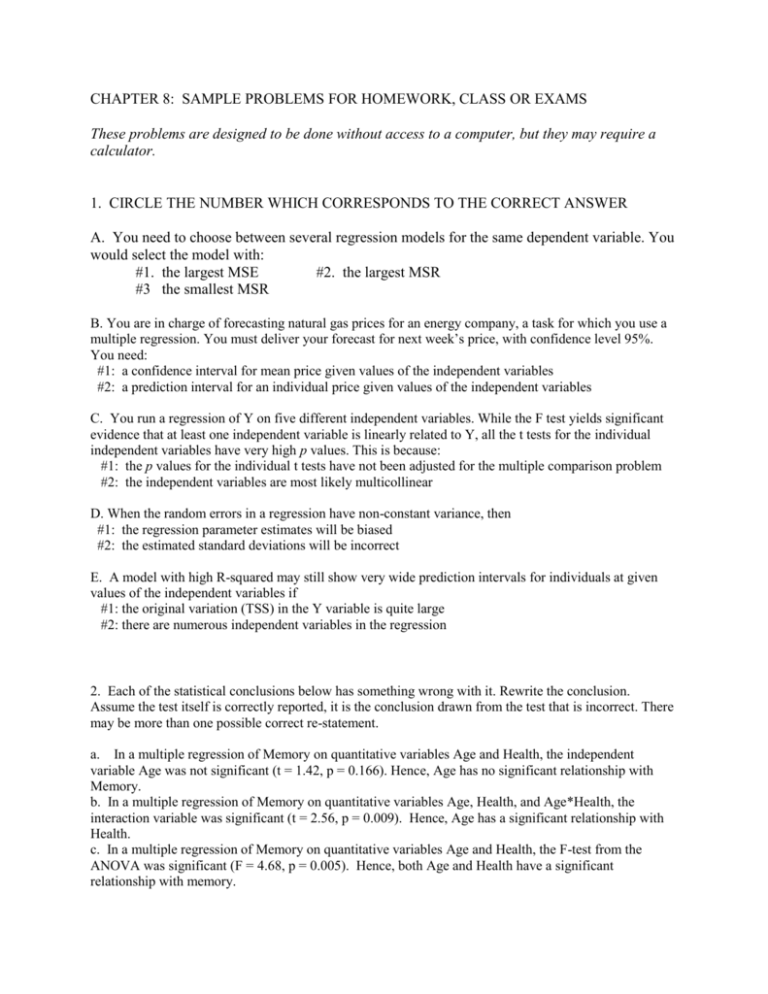
CHAPTER 8: SAMPLE PROBLEMS FOR HOMEWORK, CLASS OR EXAMS These problems are designed to be done without access to a computer, but they may require a calculator. 1. CIRCLE THE NUMBER WHICH CORRESPONDS TO THE CORRECT ANSWER A. You need to choose between several regression models for the same dependent variable. You would select the model with: #1. the largest MSE #2. the largest MSR #3 the smallest MSR B. You are in charge of forecasting natural gas prices for an energy company, a task for which you use a multiple regression. You must deliver your forecast for next week’s price, with confidence level 95%. You need: #1: a confidence interval for mean price given values of the independent variables #2: a prediction interval for an individual price given values of the independent variables C. You run a regression of Y on five different independent variables. While the F test yields significant evidence that at least one independent variable is linearly related to Y, all the t tests for the individual independent variables have very high p values. This is because: #1: the p values for the individual t tests have not been adjusted for the multiple comparison problem #2: the independent variables are most likely multicollinear D. When the random errors in a regression have non-constant variance, then #1: the regression parameter estimates will be biased #2: the estimated standard deviations will be incorrect E. A model with high R-squared may still show very wide prediction intervals for individuals at given values of the independent variables if #1: the original variation (TSS) in the Y variable is quite large #2: there are numerous independent variables in the regression 2. Each of the statistical conclusions below has something wrong with it. Rewrite the conclusion. Assume the test itself is correctly reported, it is the conclusion drawn from the test that is incorrect. There may be more than one possible correct re-statement. a. In a multiple regression of Memory on quantitative variables Age and Health, the independent variable Age was not significant (t = 1.42, p = 0.166). Hence, Age has no significant relationship with Memory. b. In a multiple regression of Memory on quantitative variables Age, Health, and Age*Health, the interaction variable was significant (t = 2.56, p = 0.009). Hence, Age has a significant relationship with Health. c. In a multiple regression of Memory on quantitative variables Age and Health, the F-test from the ANOVA was significant (F = 4.68, p = 0.005). Hence, both Age and Health have a significant relationship with memory. 3. A researcher has collected data on log(Income) for 600 men in Jacksonville. Log(Income) is used as the independent variable in a series of multiple regressions using independent variables X1 = Age in years X2 = Years of Education X3 = Race (0=white/1=nonwhite) . The full model has SSE(Int, X1, X2, X3, X1*X2, X1*X3, X2*X3) = 35.38. Various simpler models had SSE(Int, X1, X2, X3) = 35.90 SSE(Int, X1, X3, X1*X3) = 36.09 SSE(Int, X2, X3, X2*X3) = 49.85 SSE(Int) = 66.10 Int is short for Intercept, that is, 0 . a. What is R-squared for the full model? b. Test the null hypothesis that X2 has no association of any kind (either alone or through an interaction). Use = 5%. 4. You are carry out a regression of child’s Reading Score on the independent variables AGE (in years), MOM (Mother’s years of formal education), INCOME (household income in $1000s). Part of the regression printout is summarized below. There were 200 children in the sample. Variable Parameter Estimate Standard Error Intercept -29.4 6.32 AGE 8.56 1.68 MOM 1.24 .35 INCOME .28 .095 a. Give a 95% confidence interval for the increase in mean reading scores if INCOME increases by 10 ($10,000), if AGE and MOM’s education are held constant. b. Previous research had indicated that mean reading scores increased by 10 points for each additional year of AGE, provided other independent variables are held constant. Does this data provide evidence to dispute that claim? Use = 10%. 5. An urban planner is studying Y = per capita property tax base for various neighborhoods (in $1000s) as a function of X1 = average age of homes and X2 = average size of homes. Data are available for a sample of 120 neighborhoods, in which TSS = 17,136. Here is information on two models. Model 1: y 0 1X1 2X2 3X1X2 , R2 0.365 Model 2: y 0 2X2 , R2 0.303 Does Model 1 fit significantly better than Model 2, assuming = 5%? What does your result imply regarding the association with age of homes? 6. You are modeling the Hardness of polyester resins as a function of X1 = curing time. Several models are fit using polynomials in X1. Based on the SSE given below, what order polynomial would you recommend for use as a model? There were 20 observations in the data. TSS = 76 SSE from linear model = 42 SSE from quadratic model = 28 SSE from cubic model = 24 SSE from quartic model = 22 7. The effect of extra tutoring hours (X1) on math scores (Y) is being studied in high-risk High School students. We also want to control for each student’s hours per week outside class spent studying on their own (X2). Our primary emphasis is on studying the effect of X1. The regression printout is attached. a. Using the graph on the next page, plot the predicted value for Y when X2 = 0 and again when X2 = 8. Note that some of the predicted values have already been computed for you: when X1 = 0 and X2 = 0, then Yˆ = 25.4 when X1 = 3 and X2 = 0, then Yˆ = 31.0 when X1 = 0 and X2 = 8, then Yˆ = ________? when X1 = 3 and X2 = 8, then Yˆ = 63.6 b. Using your graph as a guide, explain in terms that a non-statistician can understand how extra tutoring hours (X1) affects expected math scores. Under what conditions is the extra tutoring most helpful? c. Give a 95% confidence interval for the increase in mean math scores if tutoring hours are increased by 1, AND hours spent studying on their own (X2) is held at 0. PRINTOUT FOR PROBLEM 7 Number of Observations Used 80 Analysis of Variance Source DF Sum of Squares Mean Square Model Error Corrected Total 3 76 79 6210.08235 8543.05152 14753 2070.02745 112.40857 Root MSE Dependent Mean Coeff Var 10.60229 41.36909 25.62853 R-Square Adj R-Sq F Value Pr > F 18.42 <.0001 0.4209 0.3981 Parameter Estimates Variable Intercept x1 x2 x1x2 DF 1 1 1 1 Parameter Estimate 25.39257 1.85587 1.93391 0.71724 Standard Error 4.52073 2.56473 0.87829 0.52000 t Value 5.62 0.72 2.20 1.38 Pr > |t| <.0001 0.4715 0.0307 0.1718 Variance Inflation 0 5.85170 3.07128 7.49525 80 70 60 50 40 30 20 10 0 1 X1 = 2 ext r a hour s of t ut or i ng 3 8. In an agricultural experiment, the dependent variable YIELD = 10s of pounds of tomatoes per 1000 sq ft of plantings is modeled using on FERTILZ = 10s of pounds of fertilizer per 1000 sq ft, SPRGRAIN = spring rainfall in centimeters. The attached regression printout shows the results of regressing Yield on FERTILZ, SPRGRAIN and the interaction SPRGFERT=SPRGRAIN*FERTILZ. The focus of our study is the effect of Fertilizer a. Draw a plot of expected Yield versus Fertilz when Sprgrain = 10 inches, and also when Sprgrain = 30 inches. You may superimpose your plot on the scatterplot below. Values of Fertilz ranged from 2 to 7. See fitted values already computed below. TO Help you, some of the fitted values have already been computed When SprgRain=10 and Fertilz=2 Estimated Yield = 561 SprgRain=30 and Fertilz=2 Estimated Yield = 683 SprgRain=10 and Fertilz=7 Estimated Yield = 723 SprgRain=30 and Fertilz=7 Estimated Yield = _____ ? 1100 1000 900 800 700 600 500 2 3 4 Fer t i l i z er 5 i n 10s of 6 7 pounds b. Using your plot, describe the effect of Fertilizer. Is Fertilizer more effective when spring rains are heavy or when they are light? c. Is there significant evidence, at = 5%, that at least one of the independent variables is related to Yield? Cite the appropriate test statistic and its p-value. d. Is there significant evidence, at = 5%, that adding the interaction term to a model that has SprgRain and Fertilz will improve prediction of yields? Cite the appropriate test statistic and its p-value. e. Discuss the reasonableness of the regression assumptions, citing the available evidence. PRINTOUT FOR PROBLEM 8 Number of Observations Used 93 Analysis of Variance DF 3 89 92 Sum of Squares 805740 7127.05286 812867 Root MSE Dependent Mean Coeff Var 8.94870 734.46929 1.21839 Source Model Error Corrected Total Variable Intercept fertilz sprgrain sprgfert DF 1 1 1 1 Parameter Estimate 475.28935 11.93061 2.04230 2.04754 Mean Square 268580 80.07925 R-Square Adj R-Sq F Value 3353.93 0.9912 0.9909 Parameter Estimates Standard Error t Value 12.30734 38.62 2.68275 4.45 0.61353 3.33 0.13299 15.40 Variance Inflation 0 17.13569 9.82387 26.56513 Pr > |t| <.0001 <.0001 0.0013 <.0001 Plot of Residuals versus predicted values 30 20 10 0 - 10 - 20 - 30 500 600 700 800 pr edi ct ed 900 yi el d Pr > F <.0001 1000 1100 SOLUTIONS 1 a. #2 b. #2 c. #2 d. #2 e. #1 2 a. There is no significant evidence that Age is related to Memory, provided Health is kept constant. b. There is significant evidence that the relation of Age with Memory varies by value of Health. OR There is significant evidence that the relation of Health with Memory varies by value of Age. c. There is significant evidence that at least one of Health or Age have a relationship with Memory. 3. a. R-squared = (66.1 – 35.38) / 66.1 = 0.465 b. 36.09 35.38 (596 593) F 3.97 35.38 / 593 with 3 and 593 df. The critical value is 2.60. There is significant evidence that X2 has some type of association with ln(Income). 4. a. 10 0.28 1.96 * 0.095 (0.94,4.66) With confidence 95%, if income increases by 10 units, then the expected increase in reading score is between 0.94 and 4.66 units. b. Ho: age 10 . t 8.56 10 0.857 with 196 df. There is no significant evidence that 1.68 the claim is incorrect. 5. For model 1, SSE = (1-0.365)*17136 = 10881.36 with 114 df For model 2, SSE = (1 – 0.303)*17136 = 11943.792 with 116 df F = 5.66 with 2 and 114 df. There is significant evidence that average age has some type of association with per capita property tax base. 6. The MSE from the full quartic model is 22/(20-5) = 1.467. The sequential sums of squares, beginning with a model that only has an intercept, would be Source SS F Linear 76-42 = 34 23.18 Quadratic 42-28 = 14 9.54 Cubic 28-24 = 4 2.73 Quartic 24-22 = 2 1.36 The critical value with 1 and 15 df is 4.54. This suggests that a quadratic model would fit the data adequately. 7. a. When X1=0 and X2=8, then Yˆ =40.86 b. The dashed line shows the relation of Y with X1 when X2 (time outside class) is 0. The solid line is when X2 is 8. Extra tutoring only has a small impact on expected scores when the student does not spend any extra hours outside of class. However, if the student does spend extra hours outside of class, the tutoring is associated with a great increase in scores. c. This is a confidence interval for 1 . 1.85591.9921(2.5647) = (-3.25,6.97) When there is no extra time outside class, the tutoring does not have any significant effect. 8. a. When Sprgrain=30 and Fertilz=7, predicted yield is 1050 b. The graph shows that increasing Fertilizer is always associated with increasing levels of yield, but that the impact of increasing fertilizer is stronger when there is greater spring rain. c. F = 3353.93, p < 0.0001, there is extremely strong evidence that at least one of the independent variables is associated with yields. d. t = 15.4, p < 0.0001, yes there is significant evidence that adding an interaction to the model that has Sprgrain and Fertilz will improve prediction. e. The residual plot does not show any crescent shape, that is, no sign of nonlinearity, nor any flare, that is no sign of nonconstant variance. There are no obvious outliers.

